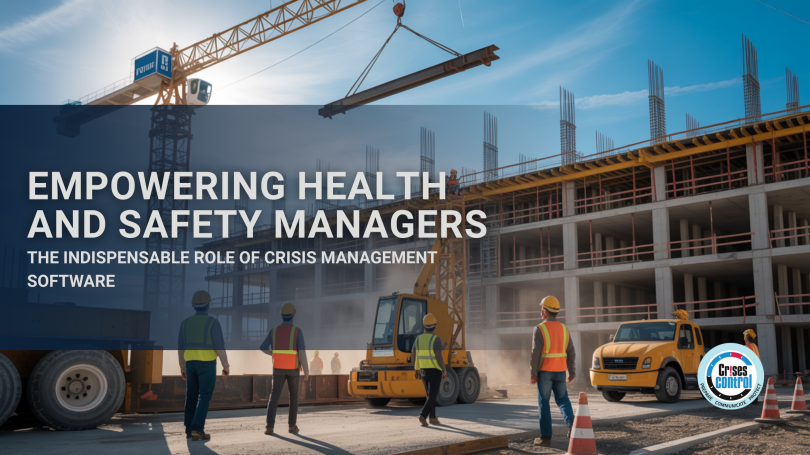Are you a health and safety manager juggling multiple responsibilities and constantly grappling with the ever-present risk of workplace crises? If so, you’re no stranger to the immense pressure of safeguarding employees’ well-being and organisational continuity. But what if there was a game-changing solution that could alleviate your challenges and elevate your crisis management capabilities? Enter the world of crisis management software (CMS), a powerful tool designed to help health and safety managers like you navigate crises with confidence and efficiency.
In this blog, we explore the vital role of a CMS in empowering health and safety managers. Discover the advantages it brings, such as real-time alerting, streamlined processes, and data analytics. Join us as we unlock the potential of this transformative tool for navigating crises, protecting your workforce, and ensuring business continuity.
Understanding Crisis Management Software
A CMS is a powerful tool designed to assist organisations in planning, responding, and recovering from various crises efficiently. It provides a centralised platform that enables health and safety managers to coordinate their actions, communicate effectively, and make informed decisions during critical situations.
Benefits of a Crisis Management Software
Implementing a CMS offers numerous benefits to health and safety managers. It enhances their ability to:
- Mitigate Risks: By proactively identifying potential risks and creating response plans, health and safety managers can minimise the impact of crises on their organisations.
- Improve Response Time: It enables swift communication and coordination, reducing response time and allowing for prompt action.
- Enhance Collaboration: The software facilitates seamless collaboration among stakeholders, ensuring everyone is on the same page and working towards a common goal.
- Centralise Information: With all relevant data and resources in one place, health and safety managers can access critical information instantly, enabling faster and more informed decision-making.
- Track and Analyse Incidents: It provides the ability to track and analyse incidents, allowing for continuous improvement and learning from past experiences.
Streamlining Communication with a Mass Notification System
Effective communication is essential during a crisis. Softwares such as Crises Control incorporates mass notification systems, allowing health and safety managers to send real-time alerts, updates, and instructions to employees, stakeholders, and relevant authorities. Mass notification ensures that crucial information reaches the right people promptly, enabling them to take appropriate actions and stay safe.
Ensuring Health and Safety Compliance
Health and safety compliance is a top priority for organisations across industries. CMS assists health and safety managers in adhering to regulatory requirements and industry standards. It helps automate compliance processes, monitor safety protocols, and generate reports to demonstrate compliance during audits or inspections.
Enhancing Incident Response and Recovery
When a crisis occurs, the ability to respond swiftly and effectively is crucial. CMS like Crises Control provide health and safety managers with predefined response plans, workflows, and checklists to guide their actions. It enables them to initiate appropriate response measures, assign responsibilities, track progress, and ensure a coordinated effort to minimise the impact of the crisis. Additionally, the software facilitates efficient recovery by streamlining post-incident assessment and enabling the implementation of corrective actions. Check out Crises Control’s Incident Task Manager.
Customisable Solutions for Diverse Organisations
Each organisation has unique requirements and workflows when it comes to crisis management. Leading crisis management software, Crises Control offers customisable solutions to align with the specific needs of different industries, sizes, and organisational structures. Health and safety managers can tailor the software to match their processes and integrate it seamlessly into their existing systems.
Key Features to Look for in a Crisis Management Software
When evaluating a CMS, health and safety managers should consider the following key features:
- Emergency Planning: The software should allow for the creation and maintenance of emergency response plans, ensuring they are up to date and easily accessible.
- Real-time Communication: Look for a system that offers instant messaging, SMS, email, and other communication channels to disseminate critical information quickly.
- Incident Reporting and Tracking: The software should provide the ability to report incidents, track their progress, and generate comprehensive reports for analysis and improvement.
- Mobile Accessibility: Mobile compatibility enables health and safety managers to access and manage crisis-related information on the go, ensuring timely and effective response.
- Training and Testing: Look for features that facilitate training simulations and exercises to ensure preparedness and validate the effectiveness of response plans.
The Importance of Training and Testing
While a CMS provides powerful capabilities, proper training and regular testing are essential to harness its full potential. Health and safety managers should conduct training sessions to familiarise employees with the software and ensure they understand their roles during crises. Regular testing and simulation exercises help identify gaps, refine response plans, and increase overall preparedness.
Integrating Crisis Management Software with Existing Systems
To maximise efficiency and effectiveness, it is crucial to integrate CMS with existing organisational systems and tools. Seamless integration allows for the exchange of data and information between different systems, eliminating duplication of efforts and ensuring a unified approach to crisis management.
Choosing the Right Crisis Management Software
Selecting the appropriate CMS requires careful evaluation. Health and safety managers should consider their organisation’s specific needs, scalability, user-friendliness, customer support, and integration capabilities. It is recommended to test tto assess the software’s suitability and ensure it aligns with the organisation’s objectives.
Conclusion
A CMS plays an indispensable role in empowering health and safety managers to navigate crises effectively. By providing streamlined communication, ensuring compliance, enhancing incident response, and offering customisable solutions, CMS equips organisations to handle crises with confidence. To stay ahead in today’s uncertain world, embrace the power of CMS and protect your workforce proactively.
Are you ready to empower your health and safety managers with effective CMS? Request a live demo or get in touch with our experts at Crises Control to learn how our solution can benefit your organisation. Ensure your workforce’s safety, streamline communication, and enhance your crisis response capabilities with Crises Control.







